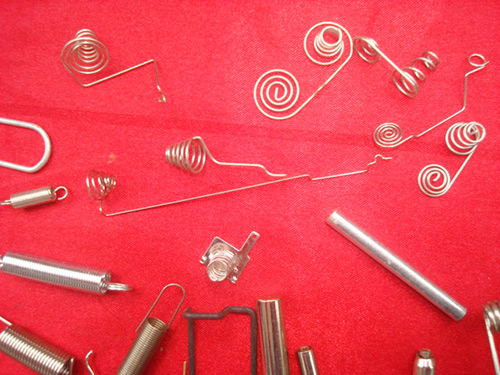4Company dynamics

1. Springs are divided into three groups according to their working characteristics
(1). Springs subjected to dynamic load (that is, the force is stretched and shrunk suddenly, many times), and when the spring is damaged, it will cause the entire mechanism to malfunction. For example, engine valve springs, friction clutch springs, electromagnetic brake springs, etc.
(2) Springs subject to static load or uniform load increase, such as springs for safety valves and pressure reducing valves, springs for brakes and transmission devices, etc.
(3). Unimportant springs, such as check valve springs, springs for manual devices, door springs and sofa springs.
2. Divided into three levels according to manufacturing accuracy
Level 1 accuracy: springs with a force-deformation deviation of ±5%, such as springs that require accurate adjustments such as governors and instruments.
Level 2 accuracy: springs with a force-deformation deviation of ±10%, such as springs for safety valves, pressure reducing valves and check valves, and springs for internal combustion engine intake and exhaust valves.
Level 3 accuracy: springs with a force-deformation deviation of ±15%, springs that do not require accurate load adjustment, such as lifting hooks and buffer springs, brakes or coupling compression springs.
3. Determination of spring material and allowable working stress
Material classification and performance are divided according to chemical composition. Spring steel can be roughly divided into several types. Its performance is as follows:
High-quality carbon steel (such as regular, medium, and high-grade carbon spring steel wire) is a cheap spring steel with very good fatigue strength. However, if the carbon content is too high, the surface is easily decarburized during heat treatment. In addition, it cannot work normally at temperatures greater than 120°C.
Low manganese steel (such as 60Mn) is cheap and has little decarburization, but it is prone to cracks and hot embrittlement after quenching.
Silicon steel (such as 60Si2Mn) has a wide range of sources, is easy to heat treatment, and has high hardenability. The disadvantage is that the surface is easy to decarburize and easy to graphitize.
Chrome vanadium steel (such as 50CrVA) is the spring steel with the best fatigue and impact resistance. It has high mechanical properties and can work below 400°C, but the price is relatively expensive and its use is restricted.
Stainless steel, bronze or tin-zinc bronze have the characteristics of corrosion resistance, so most of the springs of this material are used in the chemical industry. However, because bronze materials are not easy to heat treatment and have poor mechanical properties, general machinery try to avoid using this type of material. Spring material.
In the winding process, spring materials can be divided into the following two types:
One is cold-wound spring material. When the wire diameter d≤8 mm, cold-wound is generally used, because some spring steel wires are cold-drawn after heat treatment in a special method by the manufacturer (such as piano wire or regular, medium, high-grade Carbon spring steel wire) has high strength, and it does not need to be quenched after cold winding, but it must be tempered at low temperature to eliminate internal stress (bronze wire should also be tempered at low temperature after cold winding). However, some spring steel wires (such as 60Si2Mn) are not heat-treated when they leave the factory. After being cold-rolled into springs, they must be quenched and tempered. The other is hot-coiled spring material, where the diameter of the steel wire d> 8 mm, or the spring index C is particularly small, or some alloy spring steel wire (such as 60Si2Mn, 50CrVA, etc.), although the diameter is not very large, but because The steel wire is too hard to be cold-wound, and the spring should be made by hot-wound, and then quenched and tempered.
